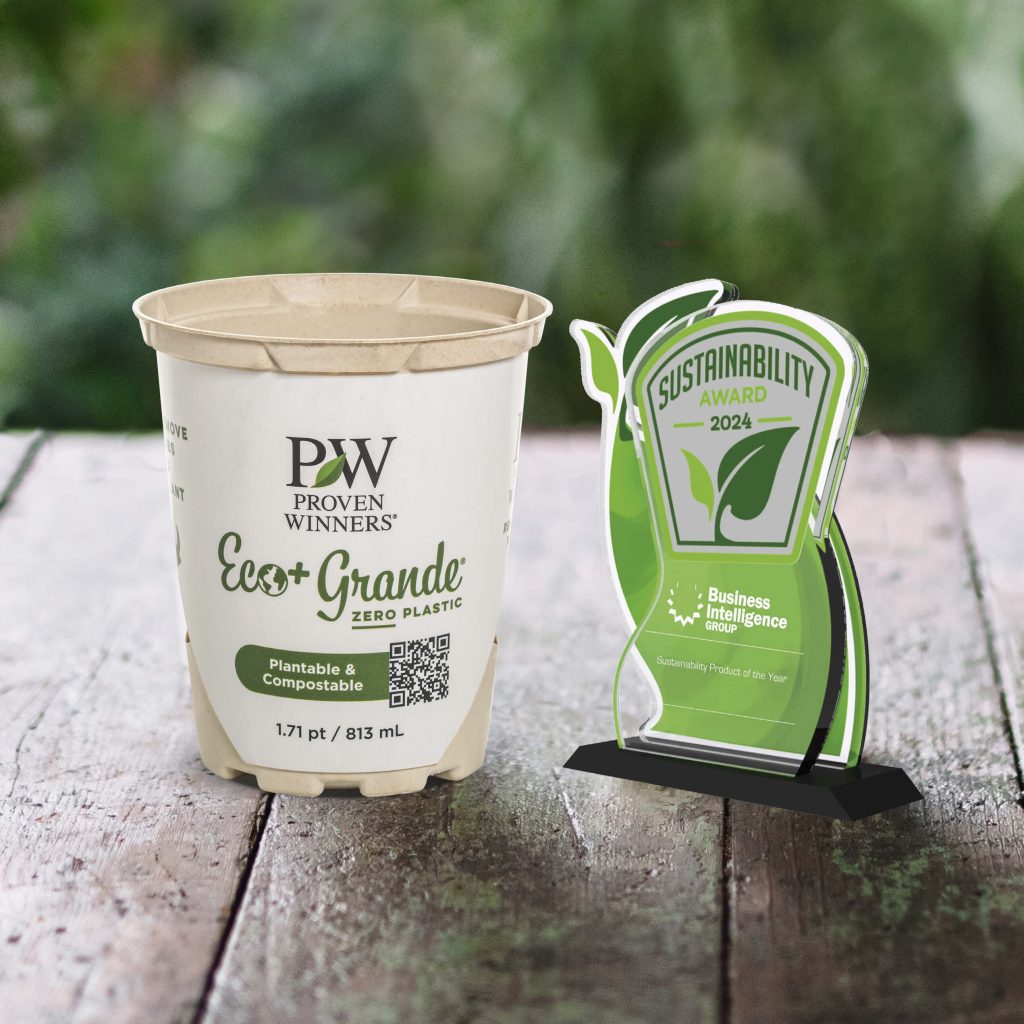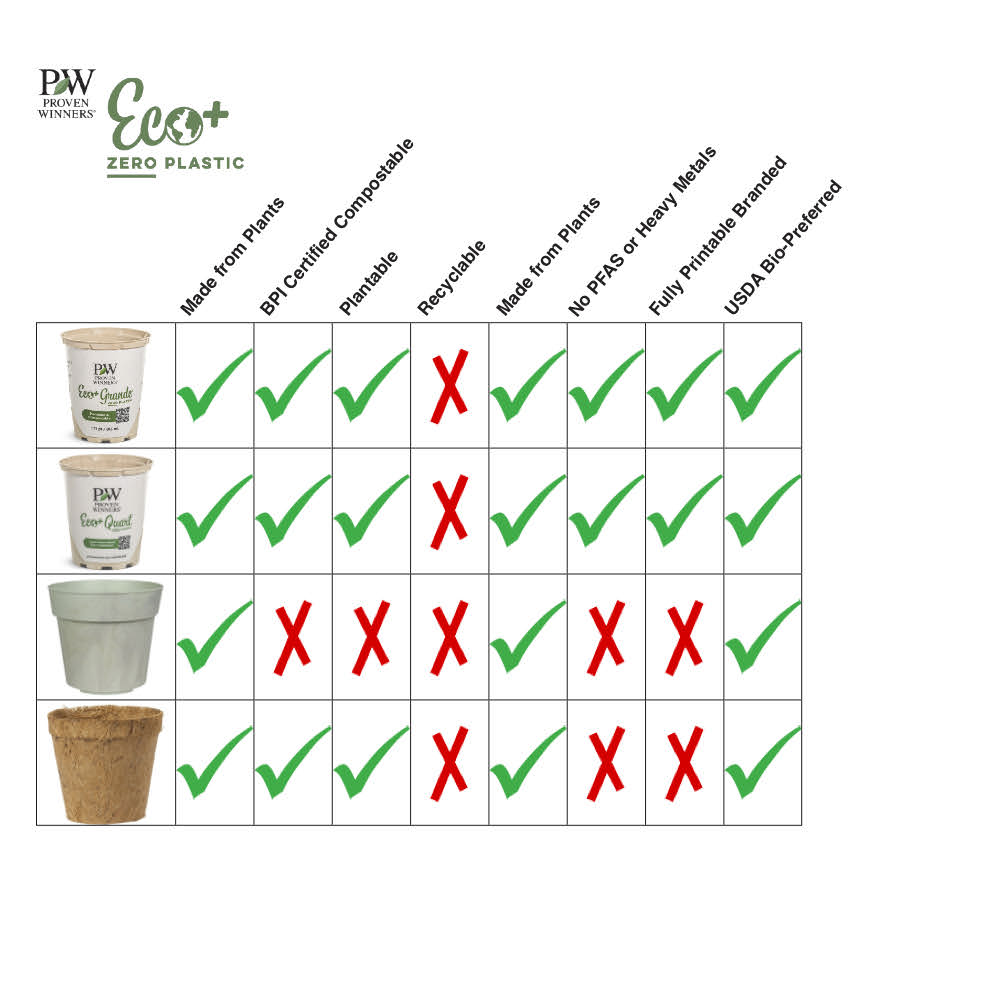Related Article:
Lawn & Garden Retail
Plant-Powered Packaging
New compostable branded containers allow growers and grower-retailers to offer plants in plant-powered, fully compostable containers.
By Susan Martin
Material
The Proven Winners® Eco+ Grande® and Eco+ Quart® Containers are industrial compostable (ASTM D6400) garden pots, made out of PLA (polylactic acid). PLA is made from natural sugars derived from corn grown right here in the U.S. Starch from these sugars is processed into a biopolymer that looks, acts, and performs like its traditional cousin: petroleum-based plastics.
Proven Winners® Eco+ Containers have plant nutrients built right into the walls of the container – however, as your plants mature, we recommend feeding them regularly to ensure maximum growth and flower. These containers are rich in natural nutrients like proteins and amino acids. As Eco+ Containers break down, it releases these nutrients and proteins slowly and directly into the roots. This helps the plants grow bigger and faster all season long.


3 Ways to Dispose of Eco+ Containers
Plant Them Directly in the Ground
Since Eco+ containers are made of natural materials that biodegrade over time, they can be planted directly into the ground without first removing the plant. But first, be sure to pull off the tabs at the bottom of the Eco+ container and remove them so the plant’s roots can expand into the surrounding soil.
Toss the removed tabs into the bottom of the planting hole. Then, set the plant potted in the Eco+ container into the hole so it is level with the surrounding soil. Backfill the hole with soil, then water thoroughly. As the container slowly disintegrates, it releases natural nutrients which feed your plant.
Use Your Community’s Compost Services
Check with your local municipality about the composting services they offer. Many communities have industrial composting programs in place for disposing of plant-based plastics, food waste, yard waste, and other organic materials.
Throw Them Away
Even if you choose to throw your Eco+ containers away, they will still break down in the landfill hundreds of years faster than traditional plastic containers. But remember that Eco+ containers are made of 100% natural materials and contain valuable nutrients that can be used to enrich your soil, so think twice before you throw this resource away.
How to Plant an Eco+ Container
Ready to plant your Eco+ Container? Pull the tabs to allow the plant’s roots to develop properly. Then, transplant the entire Eco+ Container into a larger planter or the ground. Water thoroughly.
STEP 1: PULL
Pull off the four tabs on the sides of the pot and toss them into the planting hole where they will naturally degrade over time. The tab slots in the pot allow the roots to grow out into the surrounding soil.
STEP 2: PLANT
Plant the entire Eco+ Container in the ground. Yes, the whole darn thing! It’s made of natural, compostable materials.
STEP 3: WATER
Water your plant well after planting. Eco+ Containers will naturally disintegrate over time, helping to feed the plant’s roots with natural nutrients that are rich in proteins and amino acids.
Eco+ Container Benefits
Erco+ containers prevent stress on plants by eliminating root disturbance since you can plant the entire plant and Eco+ Container into the ground once the 4 tabs are removed. With nutrients built into the walls of the Eco+ Container, you won’t have to worry about fertilizer run-off – in addition to remembering to feed your plants weekly!
What happens if parts of my Eco+ Container are still left after the growing season?
Since every gardening environment is different, your Eco+ Container may break down into very small pieces over a growing season or you may have larger segments of your Eco+ Container left. Any parts of the container that are still recognizable at the end of the season can be tilled up. The nutrients they contain will enrich your soil for the next growing season.
Can Eco+ Containers go into my local industrial composting bin?
If your area supports industrial composting and you do not want to plant your Eco+ Container in the ground or till it up for next year, you can put it in your curbside compost bin that gets picked up for industrial composting. This process is where the industrial composter takes and manages all the organics from plant-based plastics, food waste, yard waste, etc., and puts them into windrows. These windrows get to 160 degrees and help break everything down into usable compost. These containers have been tested by a 3rd party and certified for industrial composting, achieving ASTM D6400 standards.
Remember, these plant-based PLA products continue to get smaller and smaller until microbes consume them and turn them back into inert organic products.
How long do Eco+ containers last above ground with plant/soil in them?
The Eco+ Container begins to break down with a combination of heat and moisture so it’s advisable to plant them as soon as you’re able to allow your plants to flourish.
How is plastic made from plants?
Instead of drilling deep into the earth for oil to make plastics, scientists have found a way to break down plants into natural sugars which then can be used to produce a new breed of Earth-friendly plastics called PLA (polylactic acid).
Are the Eco+ Container nutrients safe?
Yes! All Eco+ Container nutrients are natural and organic. Our products are California Prop 65 compliant and all materials are responsibly compounded in the US.

Where are Eco+ Containers made?
Eco+ Containers are proudly designed, manufactured, and assembled responsibly in Stillwater, MN.
What is the shelf life of an Eco+ Container if they are empty and not being used?
If you keep them out of the heat, direct sunlight, and moisture, we would estimate a few years. Heat and moisture are the cause of the Eco-Pots breaking down.
What happens if I throw my Eco+ Container into the Landfill?
Do not worry. Eco+ Containers will break down faster in the landfill than the traditional petroleum garden pots. Plus, we didn’t need to drill for oil to produce it.
I noticed some Eco+ Containers are lighter in color than others. Is this okay?
Yes, not a problem at all. Since Eco+ Containers are made from natural materials, there are sometimes variances in the coloration of the PLA material. This will not impact the performance of the Eco+ Containers, nor deter plants from growing properly.
Will the corn in the pots affect one’s allergies?
Triggers of allergic responses are antigens, often proteins, which can be found in air, food, and water. In the case of corn allergens, profilin, a protein, has been identified in corn and many other plant (food) extracts. When food is heated past the heat-labile point, its chemical configuration changes. Due to the extreme heat and numerous processing steps to convert corn into the material that is used to make the Eco+ Container, it would not contain immunologically reactive profilin and therefore no concerns regarding allergic reactions.

*The Proven Winners® Eco+ Containers are an industrial compostable (ASTM D6400) garden pot.
Growers and Grower Retailers – Learn more about growing with our Eco+ containers
